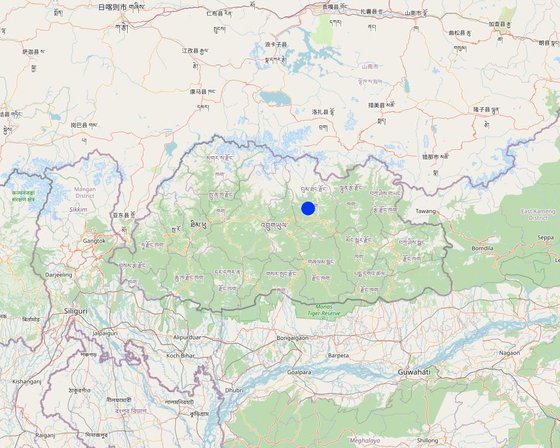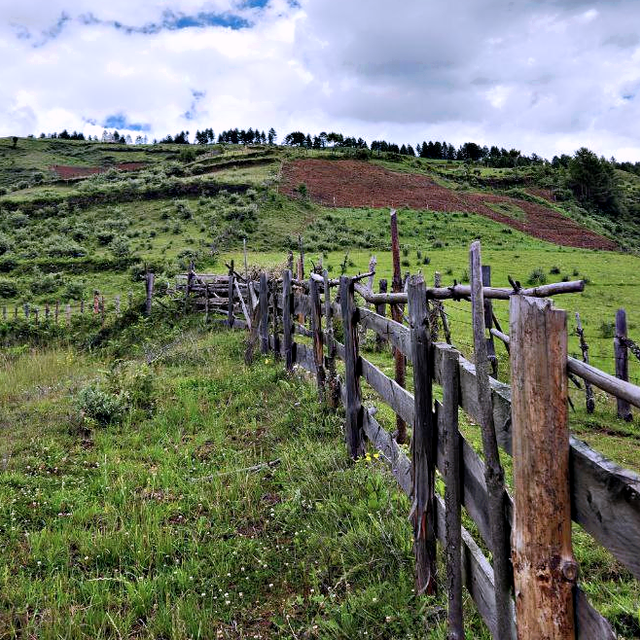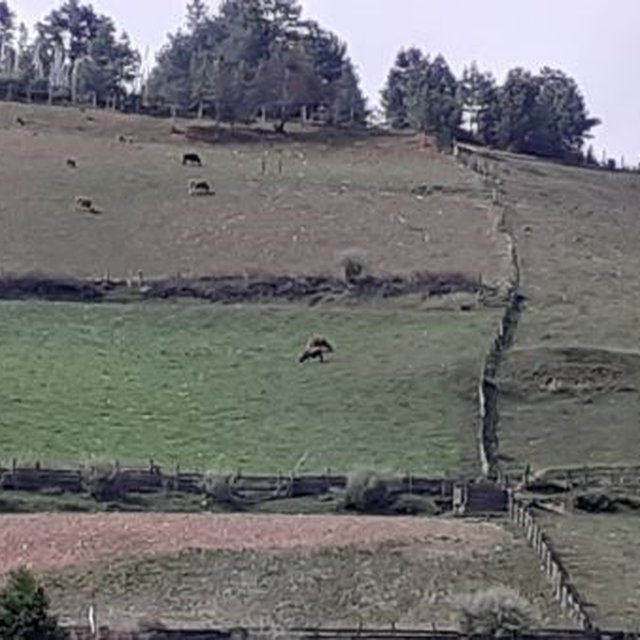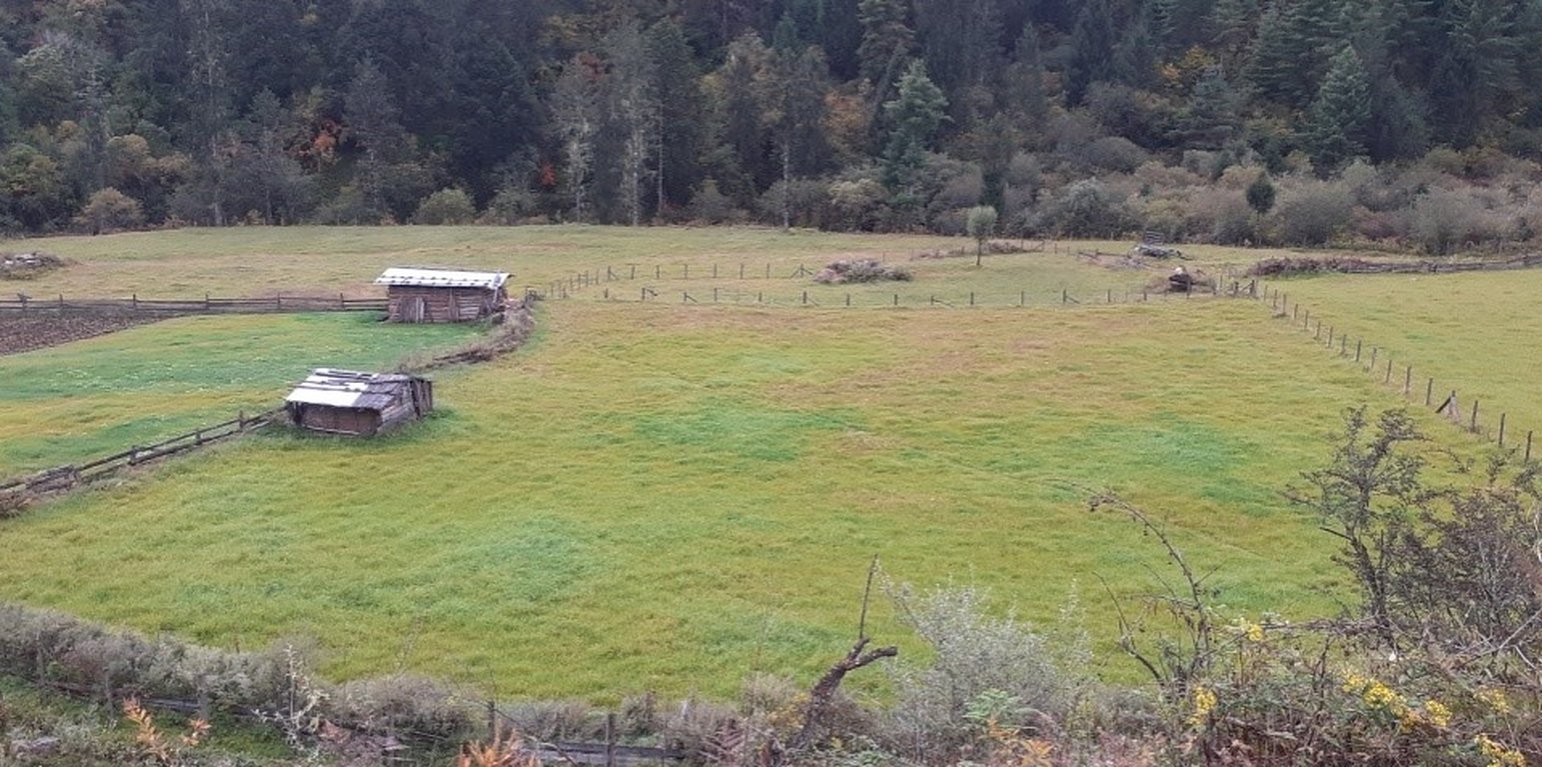Improved Pasture Development
(Bután)
Tsamdro Yardrak Tangthang (ཙྭ་འབྲོག་ཡར་དྲག་བཏང་ཐངས་།)
Descripción
The improved pasture development approach focuses on enhancing pasture productivity, which is managed sustainably for grazing. Livestock productivity depends greatly on improved pastures. It is very important to manage pastures to support the livelihoods of rural communities in Bhutan.
The improved pasture development approach in Bhutan started at the beginning of the 5th Five Year Plan (1982-1987). Thangbi village, Bumthang, focuses on enhancing pastureland productivity and sustainability through the cultivation of improved varieties of grasses provided by the project. This initiative not only prevents land degradation and erosion but also enhances fertility by introducing leguminous species like clover. In temperate areas, improved pasture consists of a mixture of white clover, tall fescue, cocksfoot, and Italian ryegrass while in the subtropical areas, green leaf desmodium, molasses grass (Melinis sp.), ruzi grass (Brachiaria sp.), and stylo are grown.
Given the significant role livestock plays in the livelihood of Bhutanese communities, where productivity is strongly influenced by seasonal variations in fodder availability, improved pasture development addresses crucial objectives. These are: 1) Enhancing the resilience of pasture ecosystems to ensure continuous, high-quality fodder production; 2) Increasing forage availability and quality by promoting the cultivation of improved fodder species; and 3) Improving livestock productivity, directly impacting income generation through increased yields of animal products - especially of milk, cheese, and butter.
Implementation involves four stages: 1) Initial assessments of pasture conditions and land suitability, conducted by livestock extension officials; 2) Planning sessions involving officials from the Department of Livestock and land users; 3) Establishment of the identified areas for growing improved fodder species; and 4) Management of improved pasture plots by land users, accompanied by regular monitoring and evaluation to ensure effectiveness.
Key stakeholders in this approach include livestock extension agents and community members. Livestock extension agents act as a liaison between the community and the government. They also procure and distribute fodder grass seeds. Community members establish pastures in their farms, taking on responsibilities such as monitoring the water supply and caring for the grasses throughout their growing seasons.
Land users appreciate the approach because it ensures abundant fodder availability year-round, improving milk production through the cultivation of superior grass species, and reducing the workload associated with foraging in forests or tending grazing cows. However, concerns raised by land users include a reduction in cultivable land due to fodder grass cultivation and a lack of training regarding fodder management for those involved in the approach.
Lugar

Lugar: Thangbi Village, Choekhor Gewog (Block), Bumthang Dzongkhag (District), Bután
Georreferencia de sitios seleccionados
Dato de inicio: 1980
Año de conclusión: n.d.
Tipo de Enfoque
-
tradicional/ local
-
iniciativa local reciente/ innovadora
-
proyecto/ basado en un programa

Pasture land established in Thangbi village (Tshewang Phuntsho)

Improved Pasture land (Wangchuk, National Centre for Animal Health, Bumthang)
Metas del Enfoque y entorno facilitador
Propósitos/ objetivos principales del Enfoque
1) Enhance the resilience of pasture ecosystems: For countries like Bhutan, fodder production is largely affected by season and during off season, the productivity goes down drastically, leaving many land users in distress. Therefore, improved pasture development enables land users to continuously harvest quality fodder for their cows.
2) Increase forage availability and quality: The improved pasture development approach not only focuses on the production of fodder in quantity but also the quality by encouraging land users to grow improved varieties of fodder species.
3) Improve livestock productivity: Improving productivity is the primary objective as it directly connects to the quantity of animal produce like milk, cheese, butter, etc., that affects the income generated.
Condiciones que facilitan la implementación de la/s Tecnología/s aplicadas bajo el Enfoque
-
Normas y valores sociales/ culturales/ religiosos: Community members/land users shared the same social, cultural, and religious norms and values. Implementation of any project didn't have any issues.
-
Disponibilidad/ acceso a recursos y servicios financieros : Community members/land users are provided with improved varieties of fodder grass for free based on the area of the land.
-
Entorno institucional: The improved pasture development has helped improve the livelihood of the community members.
-
Carga de trabajo, disponibilidad de mano de obra: The workload has relatively decreased: In the past, community members had to go to the forest to either collect fodder or look after cow that graze on the grasses, but now pasture grass is readily available.
Condiciones que impiden la implementación de la/s Tecnología/s aplicadas bajo el Enfoque
-
Conocimiento de MST, acceso a apoyo técnico: The land users know that pasture development is directly related to SLM, however land users didn't receive any trainings on the improved pasture development through the approach.
Participación y roles de las partes interesadas involucradas
Partes interesadas involucradas en el Enfoque y sus roles
| ¿Qué partes interesadas/ entidades implementadoras estuvieron involucradas en el Enfoque? |
Especifique las partes interesadas |
Describa los roles de las partes interesadas |
| usuarios locales de tierras/ comunidades locales |
Community members |
Receive the fodder grass seeds and establish pasture lands in their registered lands. He/she also monitors the water requirement and takes care of the grasses throughout its growing seasons. |
| Department of Livestock, Ministry of Agriculture and Livestock |
Livestock extension agent |
The livestock extension agent act as a bridge between the community and the governments. He/she handles the project at the grassroots level by meeting and discussing improved pasture development personally with the interested land users. He/she is responsible for procuring the seeds of fodder grasses and distributing them to the community members. |
Involucramiento de los usuarios locales de tierras/ comunidades locales en las distintas fases del Enfoque
ninguno
pasivo
apoyo externo
interactivo
auto-movilización
iniciación/ motivación
Livestock extension agent upon consultation with research centers will carry out initial assessments of pasture conditions (which species of pasture grass species to be grown) and land suitability study.
planificación
The livestock extension agent and the community members decided on how to establish and implement the project.
implementación
In the initiation phase grass species are already identified and once planning is done. Land users will be provided seeds and they have to establish the pasture on their own.
monitoreo y evaluación
Monitoring of pasture field is normally done by the community members, and ocasionally it is monitored by the extension for scheduled reporting purpose.
Flujograma
The flow chart was created based on the information provided by the community members.

Autor: Ongpo Lepcha
La toma de decisiones en la selección de Tecnología MST
Las decisiones fueron tomadas por
-
solamente usuarios de tierras (autoiniciativa)
-
principalmente usuarios de tierras con el apoyo de especialistas MST
-
todos los actores relevantes, como parte de un enfoque participativo
-
principalmente por especialistas MST en consulta con usuarios de tierras
-
solo por especialistas MST
-
por políticos/ líderes
-
Livestock extension agent
La toma de decisiones se basa en
-
la evaluación de conocimiento MST bien documentado (la toma de decisiones se basa en evidencia)
-
hallazgos de investigaciones
-
la experiencia personal y opiniones (no documentadas)
-
Consultation with research centers
Apoyo técnico, fortalecimiento institucional y gestión del conocimiento
Las siguientes actividades o servicios fueron parte del enfoque
-
Construcción de capacidades / capacitación
-
Servicio de asesoría
-
Fortalecimiento institucional (desarrollo institucional)
-
Monitoreo y evaluación
-
Investigación
Servicio de asesoría
Se proporcionó servicio de asesoría
-
en los campos de los usuarios de tierras
-
en centros permanentes
Whenever community members require any sort of technical assistance or advisory services, Livestock Extension agent at their capacity provides the support. however, if higher intervention is required EA solicit supports from the dzongkhag, Central programs and the department of livestockand accordingly provide assistance.
Fortalecimiento institucional
Se fortalecieron/ establecieron instituciones
-
no
-
sí, un poco
-
sí, moderadamente
-
sí, mucho
Describa la institución, los roles y las responsabilidades, miembros, etc.
The livelihood of the community has been relatively better with the improved pasture development.
Tipo de apoyo
-
financiero
-
construcción de capacidades/ entrenamiento
-
equipo
-
Planting materials
Detalles adicionales
The extension agent would provide improved pasture grass seeds based on the availability of budget for seeds procurement.
Monitoreo y evaluación
Monitoring is mostly done by the community members.
Financiamiento y apoyo material externo
Presupuesto anual en dólares americanos para el componente MST
-
< 2,000
-
2,000-10,000
-
10,000-100,000
-
100,000-1,000,000
-
> 1,000,000
Precise annual budget: n.d.
The funding is mostly in terms of cost of the improved pasture grass varieties.
Los siguientes servicios o incentivos fueron proporcionados a los usuarios de las tierras
-
Apoyo financiero/material proporcionado a los usuarios de tierras
-
Subsidios para insumos específicos
-
Crédito
-
Otros incentivos o instrumentos
Análisis de impacto y comentarios de conclusión
Impactos del Enfoque
No
Sí, un poco
Sí, moderadamente
Sí, mucho
¿El Enfoque ayudó a los usuarios de tierras a implementar y mantener Tecnologías MST?
No workshop or tainings were provided to the community members, however, they relied on their traditional knowledge on pasture land management.
¿El Enfoque mejoró el conocimiento y capacidades de los usuarios para implementar MST?
Community members relied on their traditional knowledge about pasture grass management
¿El Enfoque construyó/ fortaleció instituciones, colaboración entre partes interesadas?
The livelihood of the community has relatively improved compared to the past.
¿El Enfoque empoderó a grupos en desventaja social y económica?
All the households in the community irrespective of their background were provided with the pasture grass seeds.
¿El Enfoque mejoró la equidad de género y empoderó a las mujeres y niñas?
All genders were equally encouraged to participate
¿El Enfoque resultó en mejor seguridad alimentaria/ mejoró la nutrición?
The cultivated land has decreased due to the improved pasture land
Motivación principal del usuario de la tierra para implementar MST
-
producción incrementada
-
incremento de la renta(bilidad), proporción mejorada de costo-beneficio
-
reducción de la degradación de la tierra
-
reducción del riesgo de desastres naturales
-
carga de trabajo reducida
-
pagos/ subsidios
-
reglas y reglamentos (multas)/ aplicación
-
prestigio, presión social/ cohesión social
-
afiliación al movimiento/ proyecto/ grupo/ redes
-
conciencia medioambiental
-
costumbres y creencias, moral
-
conocimiento y capacidades mejorados de MST
-
mejoramiento estético
-
mitigación de conflicto
Sostenibilidad de las actividades del Enfoque
¿Pueden los usuarios de tierras sostener lo que se implementó mediante el Enfoque (sin apoyo externo)?
Conclusiones y lecciones aprendidas
Fortalezas: perspectiva del usuario de tierras
-
Reduced workload
-
Fodder available in large amount
-
Higher milk production
Fortalezas: punto de vista del compilador o de otra persona recurso clave
-
Reduction of surface runoff
-
Increase fertility of the soil
Debilidades/ desventajas/ riesgos: perspectiva del usuario de tierrascómo sobreponerse
-
Reduction in cultivated land
-
Land users have to depend on livestock officers for seeds
Training on seed production can be given to enhance their skills
Debilidades/ desventajas/ riesgos: punto de vista del compilador o de otra persona recurso clavecómo sobreponerse
Referencias
Revisado por
-
William Critchley
-
Rima Mekdaschi Studer
-
Joana Eichenberger
Fecha de la implementación: 17 de julio de 2023
Últimas actualización: 4 de junio de 2024
Personas de referencia
-
Baleymo - Usuario de la tierra
-
Sonam Choden - Usuario de la tierra
-
Phurpa Wangmo - Usuario de la tierra
Descripción completa en la base de datos de WOCAT
La documentación fue facilitada por
Institución
- National Soil Services Centre, Department of Agriculture, Ministry of Agriculture & Livestock (NSSC) - Bután
Proyecto
- Strengthening national-level institutional and professional capacities of country Parties towards enhanced UNCCD monitoring and reporting – GEF 7 EA Umbrella II (GEF 7 UNCCD Enabling Activities_Umbrella II)
Referencias claves
-
Marzban, S. & Valizadeh, N. (2020). Pasture Development: Fundamentals and Managerial Perspectives.: https://www.researchgate.net/publication/339074876_Pasture_Development_Fundamentals_and_Managerial_Perspectives
Vínculos a la información relevante disponible en línea







